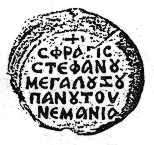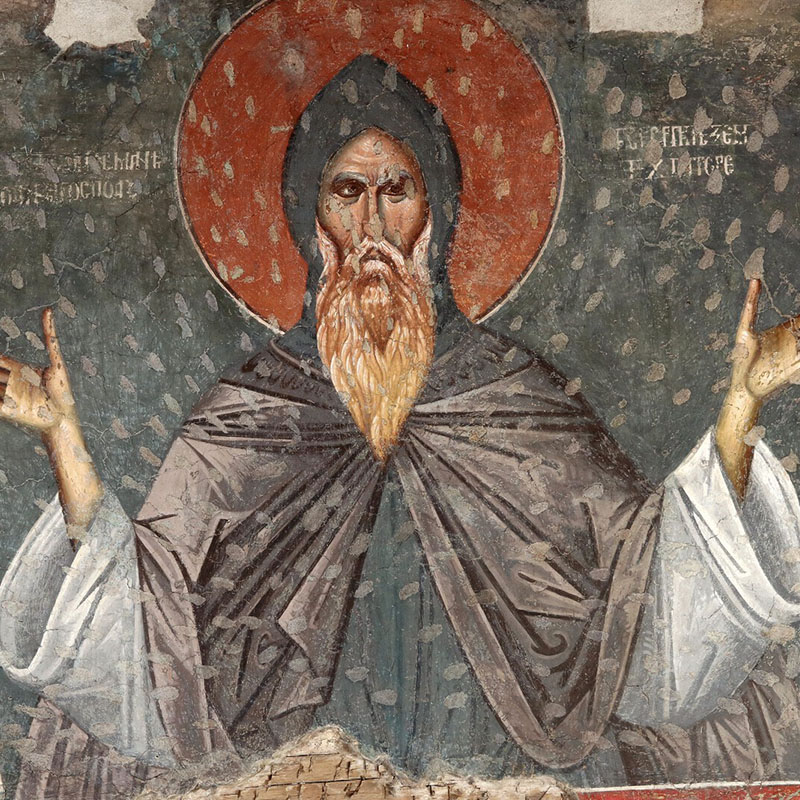Serbian Medieval History
Stefan Nemanja, Grand Zupan of Raska, (1168 - 1196)
First with brothers Miroslav and Stracimir
Nemanja (pr. NE-ma-nya; arguably related to 'Nehemiah') was born in Podgorica (POD-go-ree-tsa; modern capital of Montenegro), sometime after 1113. Although his early years are somewhat obscure - even his year of birth and the actual identity of his father Zavida are both widely disputed - Nemanja nonetheless appears to have been at least indirectly related to the Raskan ruling family. Yet, the state institutions and subsequent spiritual legacy established by him and his sons marked such a break with earlier practices, that these (probably more so than uncertainties of his lineage) marked him as a founder of a brand new dynasty - indeed, one that was to become virtually synonymous with the glory of medieval Serbia.
Nemanja's rise to power comes sometime during 1166-8, first from the appanage of Dubocica (city of Leskovac), in the shadow of his elder brother Tihomir - a Byzantine appointee - and together with the two other brethren, Stracimir and Miroslav. Rising fraternal disputes effectively dissolved this tetrarchy, leading to the decisive battle of Pantino in Kosovo, where Tihomir perished, and Nemanja - aided, tradition has it, by St. George - prevailed. He was thenceforth to reign supreme as Grand Zupan, having secured pledges of allegiance from his two surviving brothers. This assertion of unity - perhaps as much as an opportunistic attempt to ride a short-lived tide of Hungarian-Venetian aggressiveness towards Byzantium - led him on a collision course with his nominal overlord, emperor Manuel. Abandoned by Western allies and facing a superior Byzantine force, Nemanja nevertheless did show political prowess and farsightedness. His spectacular surrender to Manuel in 1172, followed by seemingly humiliating ceremonies of submission at Constantinople - all ultimately led to his return and consolidation of power and stability in an autonomous Raska for the next eight years.
Not surprisingly, however, Nemanja's loyalty to the emperor did not survive the latter's death in 1180. During the 10-year aftermath, he took advantage of Byzantine internal disorders and a more favorable international situation (which included Hungarian, Crusader, and Norman regional interests) to expand considerably in all directions at the Empire's expense. Eastward, acquisitions included, among other areas, the plains of Kosovo, the territory between Western and Great Morava (with the city of Nis, which then served as a capital), Timok, and northern Macedonia. On the other side, most Adriatic coastal and littoral regions from Zahumlje, through Travunija and Zeta, to the Lake Skadar region were added. Despite initial hostilities, relations between Raska and the important merchant city-state of Dubrovnik were settled by the 1186 treaty that provided for a symbiotic relationship between the two throughout most of the Nemanjic dynasty. Further Serbian advances were checked by Byzantine emperor Isaac II Angelos, in 1190; however, the ensuing peace treaty left most acquisitions intact for the Serbian (Raskan) state, along with full recognition and an amicable disposition from the ailing Constantinopolitan court.
Having achieved considerable political successes on all fronts, the Nemanjic dynasty founder ensured smooth succession at the Sabor (council) of Ras, in 1196. There he abdicated in favor of his middle son, Stefan, and having bequeathed all his earthly possessions, proceeded to a life of spirituality as monk Simeon. He soon joined his youngest son (the future St. Sava), at the monastic community of the Holy Mountain (Mt. Athos) in Greece, where the two were shortly to build the key center of Serbian spiritual life, the famed Hilandar (Chilandari) monastery. Nemanja's deeds as a practical earthly sovereign were matched by his religious fervor and faith, as evidenced, above all, by his numerous church foundations and other generous ecclesiastic donations. Apart from Hilandar, his key endowment - the majestic Studenica monastery - as well as Djurdjevi Stupovi and several others, remain as lasting monuments to this effect. Nemanja-Simeon was canonized shortly after his death in 1200, his feast being on Feb. 26 (13). As word of the wonderworking quality of his relics spread throughout the realm along with the awareness of his deeds, so did the general veneration of Simeon the Myrrh-flowing - as he came to be known as a result. While technically not the first Serbian saint, it was the establishment of his cult that laid the foundation for a firm national identity - backed at first by a strong state establishment, but ultimately surviving on its Christian ethics alone - for many centuries to come.
SEAL OF GRAND ZUPAN STEFAN NEMANJA
 The seal of Grand Zupan Stefan Nemanja, one of only two verified surviving specimens, was acquired in 1978 by the National Museum in Belgrade. The charter this seal was originally attached to no longer survives, but the style and Greek it is written in, indicating it as part of the rich late-12th century diplomatic activity of the rejuvenated Raskan court.
The seal of Grand Zupan Stefan Nemanja, one of only two verified surviving specimens, was acquired in 1978 by the National Museum in Belgrade. The charter this seal was originally attached to no longer survives, but the style and Greek it is written in, indicating it as part of the rich late-12th century diplomatic activity of the rejuvenated Raskan court.
Others
More Information
BLAGO Content
While the content of the BLAGO Fund collections is free to use, there are also some restrictions on commercial use and proper attribution of the material. Follow the links below for more information.
> BLAGO Collections License
> Image Request
BLAGO Fund also accepts the contribution of material. Please contact us with any material you wish to publish on our website.
Contact
BLAGO Fund, Inc.
PO Box 60524
Palo Alto, CA 94306
USA
info@blagofund.org


